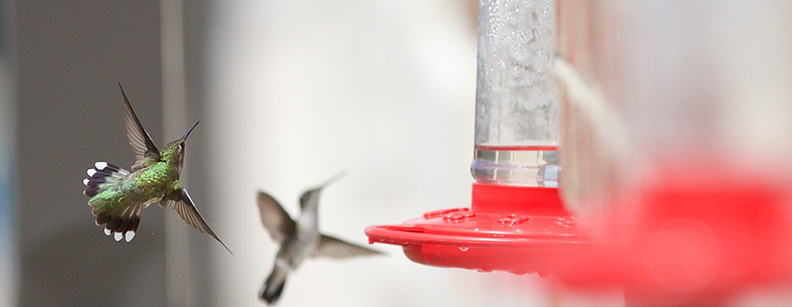

Amy Wilms' passion for hummingbirds takes flight
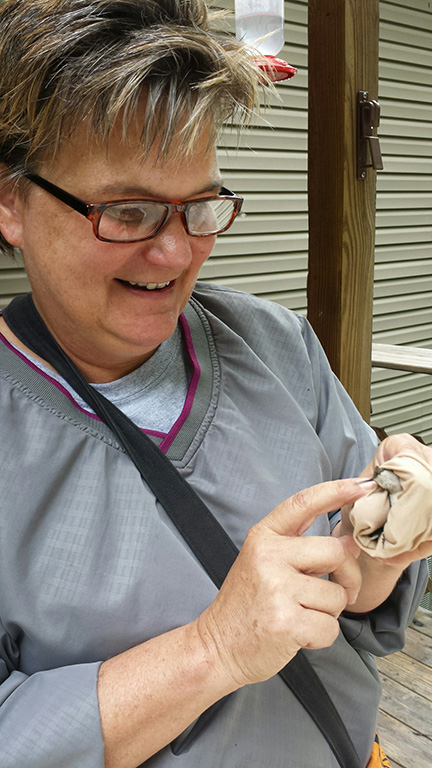
Amy Wilms holds a hummingbird to band (photo courtesy Wilms).
By Margo Kissell, university news and communications
Amy Wilms remembers the first time she walked down to the bird banding station at Hueston Woods State Park.
Dave Russell, senior lecturer in biology at Miami University and co-founder of the nonprofit Avian Research and Education Institute, had just caught an American Woodcock and was putting a tiny, aluminum band on one of its legs.
“It was just the coolest thing I’d ever seen,” said Wilms, assistant to the chair of the department of psychology and an avid bird watcher at the time.
Wilms remembers thinking how much she would love to be able to do bird banding herself some day. She became one of Russell’s volunteers and for the past six years worked toward that goal.
She volunteered at the banding station, put up nets at dawn and took Russell’s class at the Ecology Research Center that taught her skills such as determining a bird’s age and gender.
Russell’s enthusiasm for birds, the education and research “pulled it together for me,” she said. “From that point on, I thought, ‘I have to do this.’ I was totally hooked.”
Wilms now holds a subpermit to band songbirds under Russell, a master bander and master trainer licensed to handle federally protected species of songbirds.
She also holds a subpermit to band hummingbirds under Allen Chartier, a master bander of hummingbirds who lives in Michigan.
Her next goal is to become a master songbird and hummingbird bander herself.
“Every time I have a bird in my hand, I’m just amazed,” she said.
Education, research and survival
Wilms has banded more than 1,500 birds in the past two years since becoming licensed in Ohio and Indiana.
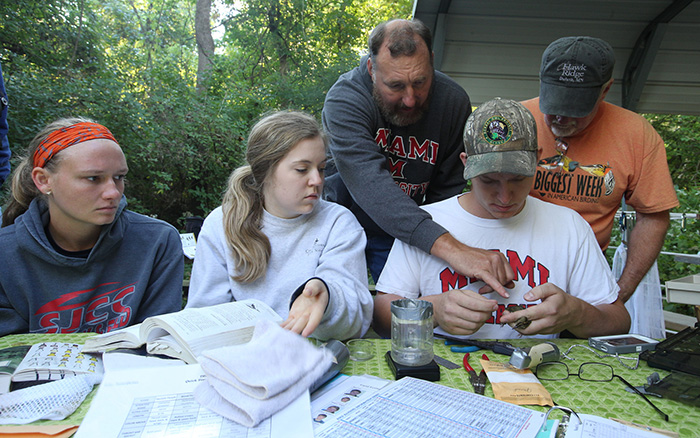
Master bander Dave Russell with students at the Hueston Woods Bird Banding Station (photo by Jeff Sabo).
Most of them have been hummingbirds, those darting, flying wonders with iridescent feathers. They earned their name because of the humming noise that results from flapping their wings so fast (80 times per second).
Russell, who runs the banding station as a classroom and training station, said he has enjoyed “every step of the way” watching Wilms grow into someone who can now band birds with ease — usually in two minutes or less.
“You can teach all the technical aspects, but you can’t teach enthusiasm and you can’t teach effort,” said Russell, adding the data she collects is “top notch.”
Wilms said it’s all about the hummingbirds’ survival. She bands them to document their age, gender and health over time to see how they are faring as a species.
“Most of them don’t make it out of their first year, so you’re talking a survival rate of less than 25 percent,” she said. “Every time you get a bird, you’re always looking for one that is a returnee.”
Gaining an appreciation of wildlife
Outside the window of her office in the psychology building in front of the butterfly/pollinator friendly gardens, Wilms hangs multiple hummingbird feeders — eight during the spring and summer; fewer now that most are flying south for the winter.
She has 20 more feeders at the Mary Gray Bird Sanctuary, where she and her husband Carl (Miami PhD ’14) live.
They manage the 700-acre wildlife sanctuary near Connersville, Indiana, that is owned by the Indiana Audubon Society. School children frequently visit and watch Wilms band birds.
“I truly believe people have a better appreciation of wildlife and of birds and of the environment when they can get up close and really experience them,” she said.
Wilms has to catch them first.
She puts a hummingbird feeder inside a special cylindrical trap that is closed on all sides except for a little door the bird enters. Because hummingbirds tend to fly up after feeding, they can’t find their way back out.
She was trained over a three-year period in how to handle the birds safely. “If I see any stress whatsoever, I let the bird go,” she said.
Flying long distance
Wilms wears reading glasses to carefully attach the tiny bands with pliers. Each band that she has cut and rounded with special equipment has a letter and five numbers laser-etched into it.
She holds each bird in the toe of a cutoff nylon stocking to gently control it.
“For the most part, once a bird gets on its back, because it’s never on it’s back, it’s very calm,” she said.
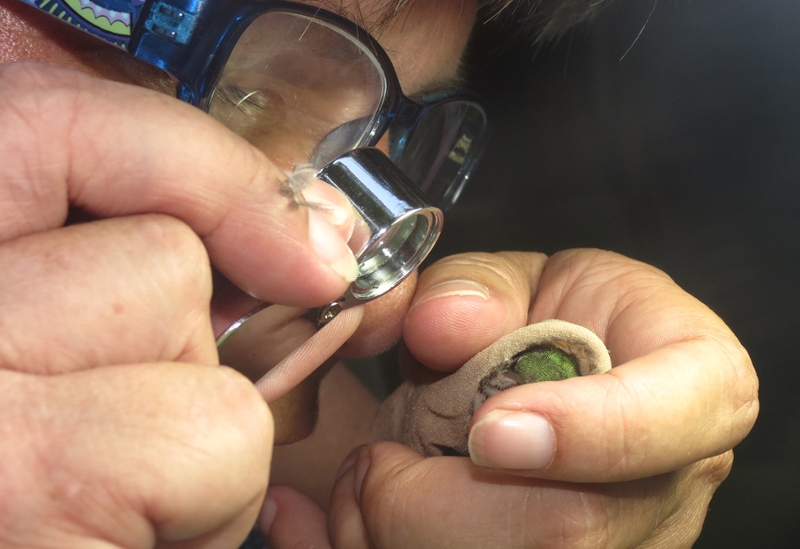
Wilms examines the beak of a hummingbird to determine its age (photo courtesy of Wilms).
Once it’s banded, she measures the length of the wing, the tail and the culmen (beak), then examines the culmen with a magnifying glass to determine the bird’s age.
If born this year, the culmen has tiny markings called groovings; if it’s an adult, it’s totally smooth.
Wilms said a lot of people who have hummingbird feeders in their backyards have told her ‘I know my bird came back year after year.’ Science backs it up.
“By putting bands on birds, we’ve found out that these birds will come back to the same location,” she said.
This time of year, most hummingbirds are flying more than 2,000 miles down to Mexico or Central America, where they’ll spend the winter and feed on protein such as small insects. (Sugar water is for our enjoyment, she noted.)
The small birds nearly double their weight before making the trip.
Wilms measures the fat by using a small straw and blowing on their belly area. The fat sort of resembles a blister, she said.
“Once they get to a certain point, I know they are heading out because they have so much fat on them,” she said.
Looking for the “returnees”
While banding hummingbirds this summer, Wilms noticed one that had been caught already had a band on it.
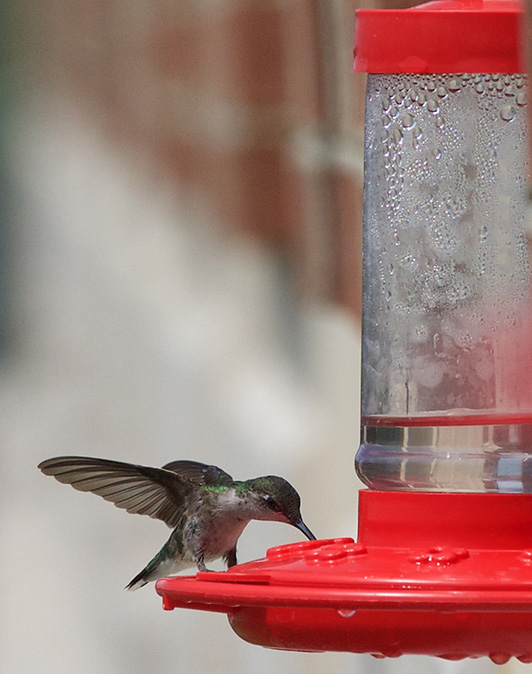 “I looked at the band and immediately I knew I had an E bird,” she said. The female hummingbird was wearing the tiny band with an E etched on it from 2012, the year she started training to band hummingbirds.
“I looked at the band and immediately I knew I had an E bird,” she said. The female hummingbird was wearing the tiny band with an E etched on it from 2012, the year she started training to band hummingbirds.
She checked her data and discovered the bird had been an adult when she was banded, so she was now at least five years old. (The average lifespan of a ruby-throated hummingbird is 3-5 years, experts estimate.)
It was a special moment and gives Wilms hope to see some hummingbirds beating the odds.
“I just wanted to cry. To think how many miles this bird has flown. You’re talking probably 2,000 to 3,000 miles a year because they’re doing these round trips — times five,” she said. She has documented two other returnees.
“The cards are stacked against them and yet they are able to survive,” she said.
